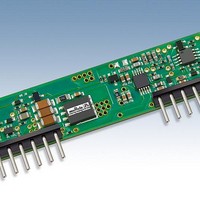LSN2-T/30-D12G-C Murata Power Solutions Inc, LSN2-T/30-D12G-C Datasheet - Page 10

LSN2-T/30-D12G-C
Manufacturer Part Number
LSN2-T/30-D12G-C
Description
DC/DC Converters & Regulators 12Vin 0.8-5Vout 30A 150W Power Good Out
Manufacturer
Murata Power Solutions Inc
Series
LSN2r
Datasheet
1.LSN2-T30-D12-C.pdf
(16 pages)
Specifications of LSN2-T/30-D12G-C
Output Power
150 W
Input Voltage Range
6 V to 14 V
Input Voltage (nominal)
12 V
Number Of Outputs
1
Output Voltage (channel 1)
0.8 V to 5 V
Output Current (channel 1)
30 A
Package / Case Size
SIP
Output Type
Low Voltage Selectable
Output Voltage
0.8 V to 5 V
Product
Non-Isolated / POL
Lead Free Status / RoHS Status
Lead free / RoHS Compliant
Other names
LSN2-T/30-D12G-C
Figure 13. Sequence/Track Simplifi ed Equivalent Schematic
Figure 11. Self-Ramping Power Up
Figure 12. Proportional Phasing
www.murata-ps.com
be characterized for start-up and down times. These often vary—one POL may
stabilize in 15 milliseconds whereas another takes 50 mS. Another problem is
that the sequencing controller itself must be “already running” and stabilized
before starting up other circuits. If there is a glitch in the system, the power
up/down sequencer could get out of step with possible disastrous results.
Lastly, changing the timing may require reprogramming the logic sequencer or
rewriting software.
Sequence/Track Input
A different power sequencing solution is employed on the LSN2-T/30-D12 DC/DC
converter. After external input power is applied and the converter stabilizes, a
high impedance Sequence/Track input pin accepts an external analog voltage.
The output power voltage will then track this Sequence/Track input at a one-to-
one ratio up to the nominal set point voltage for that converter. This Sequenc-
ing input may be ramped, delayed, stepped or otherwise phased as needed for
the output power, all fully controlled by the user’s simple external circuits. As a
direct input to the converter’s feedback loop, response to the Sequence/Track
input is very fast (milliseconds).
On/Off logic sequencer may be duplicated. The Sequence pin system does not
use the converter’s Enable On/Off control (unless it is a master emergency shut
down system).
Power Phasing Architectures
Observe the simplifi ed timing diagrams in this section. There are many pos-
sible power phasing architectures and these are just some examples to help
you analyze your system. Each application will be different. Multiple output
voltages may require more complex timing than that shown here.
typical power output voltages. Generally the Master will be a primary power
voltage in the system which must be present fi rst or coincident with any
Slave power voltages. The Master output voltage is connected to the Slave’s
Sequence input, either by a voltage divider, divider-plus-capacitor or some
other method.
cerned with three factors:
difference relationship is important for systems very concerned about possible
latchup of programmable devices or overdriving ESD diodes. Lower slew rates
avoid overcurrent shutdown during bypass cap charge-up.
If the power up/down timing needs to be closely controlled, each POL must
By properly controlling this Sequence pin, most operations of the discrete
These diagrams illustrate the time and slew rate relationship between two
Several standard sequencing architectures are prevalent. They are con-
■
■
■
For most systems, the time relationship is the dominant factor. The voltage
The time relationship between the Master and Slave voltages
The voltage difference relationship between the Master and Slave.
The voltage slew rate (ramp slope) of each converter’s output.
25 Jun 2010 MDC_LSN2-T/30-D12
LSN2-T/30-D12 Series
DOSA-SIP, 30A POL DC/DC Converters
email: sales@murata-ps.com
Series.B20Δ
Page 10 of 16






















